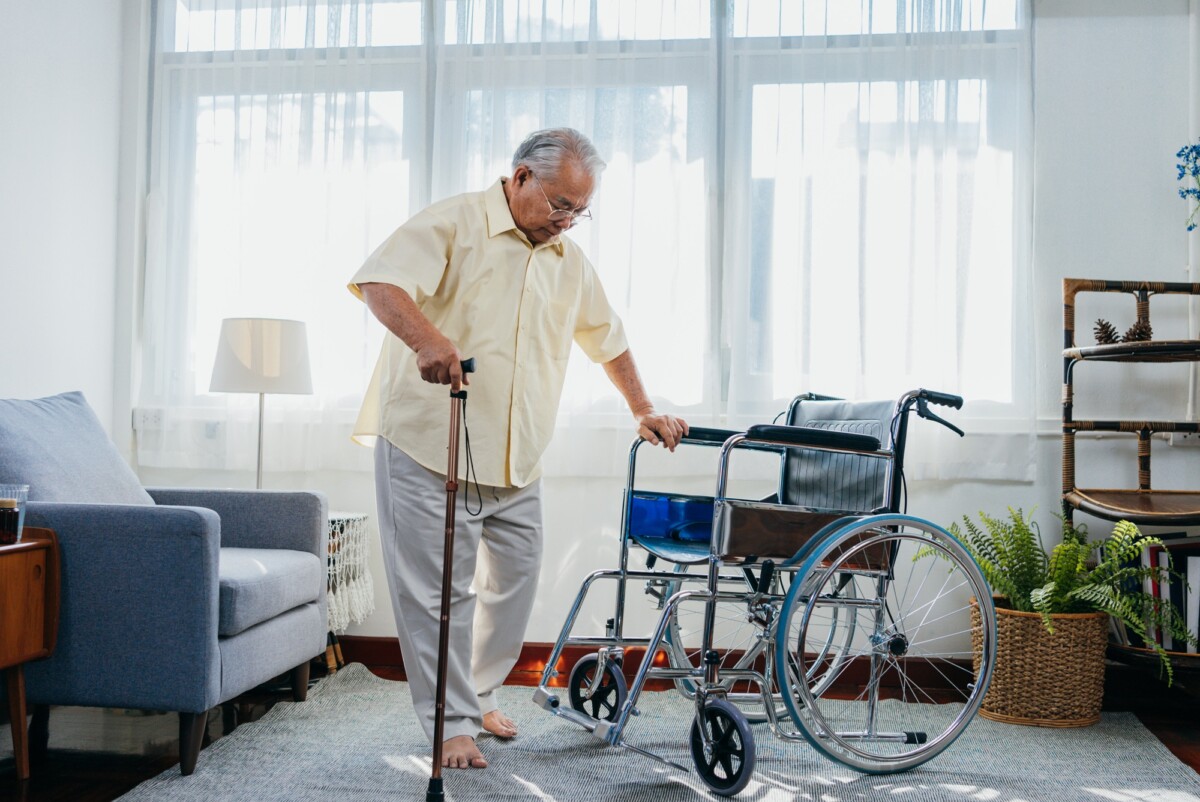Walk with Confidence: Discover the Benefits of a Wheeled Walker
A wheeled walker is a vital mobility aid that offers support and stability for individuals struggling with independent walking, particularly seniors or those recovering from surgery. These devices enhance mobility while ensuring safety, allowing users to regain confidence and manage daily activities more easily.
Benefits of Using a Wheeled Walker
Using a wheeled walker provides numerous benefits that can significantly enhance users’ quality of life.
Enhanced Stability
- Wheeled walkers offer a stable base, minimizing fall risks.
- Many feature hand brakes for better control.
These walkers help users maintain balance, which is crucial for those with muscle weakness. Studies indicate that mobility aids like wheeled walkers can reduce fall risk by up to 50%.
Increased Mobility
- They allow users to move freely and confidently.
- Suitable for both indoor and outdoor use.
Wheeled walkers promote increased mobility, enabling users to navigate their environments without fear of falling. This leads to a more active lifestyle, essential for physical and mental well-being. Statistics show that users of mobility aids are more likely to participate in social activities, reducing feelings of isolation.
Convenience and Comfort
- Many come with built-in seats for resting.
- They often include storage for personal items.
Designed for comfort, wheeled walkers allow users to rest when needed and carry essentials, making outings easier and encouraging active community engagement.
Types of Wheeled Walkers
Wheeled walkers are vital mobility aids for many, especially the elderly and those recovering from surgery. They provide essential stability and support, enabling users to maintain independence while navigating their environments. Understanding the different types of wheeled walkers is crucial for selecting the right one for individual needs.
There are several types of wheeled walkers, each designed for specific mobility requirements:
Standard Wheeled Walkers
- Feature two wheels at the front and rubber tips at the back, offering basic support for users who can bear some weight.
Ideal for indoor use on flat surfaces, they are lightweight and suitable for those needing minimal assistance.
Rollators
- Equipped with four wheels, rollators enhance mobility and often include a seat for resting during longer outings.
- Many models have hand brakes for added safety, crucial for users who may tire easily.
Heavy-Duty Wheeled Walkers
- Designed for larger individuals, these walkers provide extra support with a higher weight capacity and wider frame.
- They ensure safety and comfort for users requiring a more robust option.
Pediatric Wheeled Walkers
- Smaller and lighter, these walkers cater to children’s unique needs and often come in engaging designs.
- They help children develop mobility skills and independence safely. Research shows that using a wheeled walker can significantly reduce fall risks among older adults, making it an essential tool for safety and independence. Choosing the right type can greatly enhance users’ quality of life, allowing for confident and secure movement.
Choosing the Right Wheeled Walker
Choosing the right wheeled walker is essential for enhancing mobility and independence for those needing assistance while walking. These devices provide crucial support and stability, particularly for individuals recovering from surgery or managing chronic conditions. With numerous options available, understanding your specific needs can simplify the selection process.
Understanding Your Needs
Assessing your requirements is vital when choosing a wheeled walker. Key factors to consider include:
- Weight Capacity: Ensure the walker can comfortably support your weight.
- Height Adjustment: Look for adjustable models for optimal comfort.
- Terrain: Consider where you’ll primarily use the walker, as some are better for indoor use while others handle outdoor terrains well.
Identifying these needs helps narrow down your options effectively.
Features to Look For
Not all wheeled walkers are the same. Important features to enhance your experience include:
- Brakes: Choose walkers with easy-to-use hand brakes for safety.
- Storage: Some models include baskets or trays for carrying personal items.
- Foldability: A foldable design is convenient for transport.
Research indicates that using a walker can reduce fall risk by up to 50%, highlighting the importance of these features.
Trying Before You Buy
If possible, test different models before purchasing. Tips include:
- Visit a Medical Supply Store: Many allow in-store testing.
- Consult Healthcare Professionals: They can offer tailored recommendations.
- Check Online Reviews: Insights from others can inform your decision.
Ultimately, the right wheeled walker should feel comfortable and supportive, helping you regain confidence and mobility for a more active lifestyle.
Safety Tips for Using a Wheeled Walker
Wheeled walkers are vital mobility aids that offer support and stability for individuals struggling with independent walking, especially seniors or those recovering from surgery. They play a crucial role in maintaining balance and preventing falls. However, ensuring safe usage is essential for the user’s confidence and well-being. Here are some important safety tips for using a wheeled walker effectively.
1. Adjust the Walker to Your Height
- Make sure the handles are at the correct height, allowing your elbows to be slightly bent when standing.
- An incorrectly adjusted walker can lead to poor posture and increase fall risk. Most walkers have adjustable settings, so customize it to fit your needs.
2. Check the Walker Regularly
- Regularly inspect your wheeled walker for wear and tear, such as loose wheels or damaged brakes.
- Maintenance is key to preventing accidents, as falls are a leading cause of injury among older adults, according to the CDC.
3. Use the Brakes Wisely
- Always engage the brakes when sitting or standing to prevent the walker from rolling away.
- Release the brakes before moving for a smooth transition.
4. Practice Proper Walking Technique
- Take small, deliberate steps and move the walker forward before stepping into it, keeping your weight centered.
- Avoid leaning too heavily on the walker to prevent tipping. Proper technique can significantly reduce fall risks.
Maintaining Your Wheeled Walker
A wheeled walker is a vital mobility aid that provides stability and support, particularly for seniors and individuals recovering from injuries. These devices help prevent falls and promote safe movement, but they require regular maintenance to function effectively. Here’s how to keep your wheeled walker in top shape.
Regular Inspections
Conducting regular inspections is essential for maintaining your wheeled walker. Key areas to check include:
- Wheels and Brakes: Ensure wheels are free from debris and brakes engage properly to prevent accidents.
- Frame Integrity: Look for signs of wear or damage on the frame, as a sturdy frame is crucial for safety.
- Handles and Grips: Check that handles are secure and grips are not worn out for better usability.
Cleaning Your Wheeled Walker
Regular cleaning enhances the appearance and lifespan of your walker. Tips include:
- Use Mild Soap and Water: Clean the frame and wheels with mild soap and water to remove dirt.
- Avoid Harsh Chemicals: Do not use abrasive cleaners that could damage the walker.
- Dry Thoroughly: Ensure the walker is completely dry after cleaning to prevent rust.
Storage Tips
Proper storage contributes to the longevity of your wheeled walker. Suggestions include:
- Keep It Dry: Store in a dry place to avoid moisture.
- Avoid Extreme Temperatures: Keep it in a climate-controlled environment.
- Fold When Not in Use: Fold the walker to save space and protect it from damage.
FAQs About Walkers with Wheels and Medicare Coverage
Does Medicare pay for a walker with wheels?
Yes, Medicare Part B covers durable medical equipment (DME), including walkers with wheels, if they are medically necessary. To qualify for coverage:
- A doctor must prescribe the walker.
- You must get it from a Medicare-approved supplier.
- After meeting the Part B deductible, Medicare covers 80% of the cost, and you pay the remaining 20% (unless you have supplemental insurance).
What is the difference between a rollator walker and a wheeled walker?
- A wheeled walker (or front-wheeled walker) has two wheels in the front and two stationary legs in the back. It provides more stability and is ideal for those who need extra support but move at a slower pace.
- A rollator walker has four wheels, hand brakes, and a built-in seat. It is better for people who can walk more independently but need rest breaks.
What is a drawback to a front-wheeled walker?
One potential drawback of a front-wheeled walker is that it requires more effort to maneuver than a rollator. The back legs do not have wheels, so users must lift or drag the walker slightly when moving forward. This can make it harder to use for people with limited upper body strength or balance issues.
Are walkers with wheels safe for seniors?
Yes, walkers with wheels can be safe for seniors when used correctly and for the right mobility needs. However, safety depends on factors like:
- Proper adjustment to the user’s height
- Use of brakes (for rollators) to prevent uncontrolled movement
- Indoor vs. outdoor use – Wheeled walkers work best on smooth surfaces, while rough terrain may increase fall risk
- Individual mobility level – Seniors with severe balance issues may need a more stable option, like a standard walker or cane.
Say goodbye to high Medicare costs! Compare plans for free at Newmedicare.com or call 📞 (833) 203-6742.






